新概念第一册第三课单词课文默写
- 格式:doc
- 大小:28.50 KB
- 文档页数:1
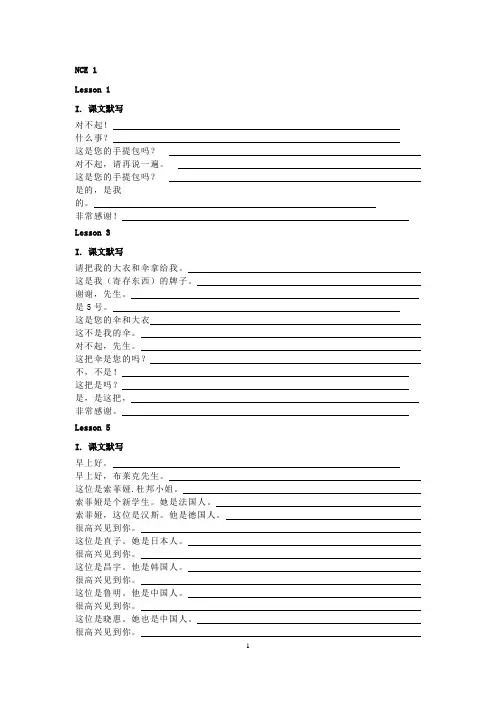
Lesson 1I. 课文默写对不起!什么事?这是您的手提包吗?对不起,请再说一遍。
这是您的手提包吗?是的,是我的。
非常感谢!Lesson 3I. 课文默写请把我的大衣和伞拿给我。
这是我(寄存东西)的牌子。
谢谢,先生。
是5号。
这是您的伞和大衣这不是我的伞。
对不起,先生。
这把伞是您的吗?不,不是!这把是吗?是,是这把,非常感谢。
Lesson 5I. 课文默写早上好。
早上好,布莱克先生。
这位是索菲娅.杜邦小姐。
索菲娅是个新学生。
她是法国人。
索菲娅,这位是汉斯。
他是德国人。
很高兴见到你。
这位是直子。
她是日本人。
很高兴见到你。
这位是昌宇。
他是韩国人。
很高兴见到你。
这位是鲁明。
他是中国人。
很高兴见到你。
这位是晓惠。
她也是中国人。
很高兴见到你。
I. 课文默写我是个新学生,我的名字叫罗伯特。
很高兴见到你。
我的名字叫索菲娅。
你是法国人吗?是的,我是法国人。
你也是法国人吗?不,我不是。
你是哪国人?我是意大利人。
你是教师吗?不,我不是。
你是做什么工作的?我是电脑录入员。
你是做什么工作的?我是工程师。
Lesson 9I. 课文默写你好,海伦。
你好,史蒂文。
你今天好吗?很好,谢谢你。
你好吗? 很好,谢谢。
托尼好吗?他很好,谢谢。
埃玛好吗? 她也很好,海伦。
再见,海伦。
见到你真高兴。
我见到你也很高兴,史蒂文。
再见。
Lesson 11I. 课文默写那是谁的衬衫?戴夫,这是你的衬衫吗?不,先生。
这不是我的衬衫。
这是我的衬衫。
我的衬衫是蓝色的。
这件衬衫是蒂姆的吗?也许是,先生。
蒂姆的衬衫是白色的。
蒂姆!什么事,先生。
这是你的衬衫吗?是的,先生。
给你。
接着!谢谢您,先生。
Lesson 13I. 课文默写你的新边衣裙是什么颜色的?是绿色的。
到楼上来看看吧。
谢谢。
瞧,就是这件。
这件连衣裙真好,真漂亮。
我的帽子也是新的。
是什么颜色的?一样的颜色,也是绿的。
真是一顶可爱的帽子!Lesson 15I. 课文默写你们是瑞典人吗?不,我们不是瑞典人。

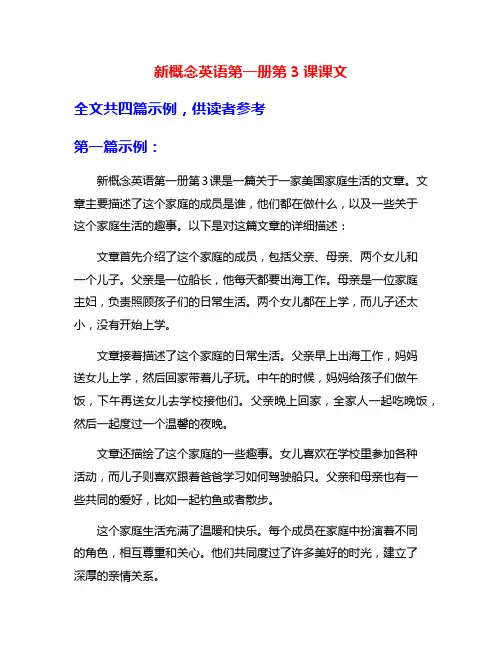
新概念英语第一册第3课课文全文共四篇示例,供读者参考第一篇示例:新概念英语第一册第3课是一篇关于一家美国家庭生活的文章。
文章主要描述了这个家庭的成员是谁,他们都在做什么,以及一些关于这个家庭生活的趣事。
以下是对这篇文章的详细描述:文章首先介绍了这个家庭的成员,包括父亲、母亲、两个女儿和一个儿子。
父亲是一位船长,他每天都要出海工作。
母亲是一位家庭主妇,负责照顾孩子们的日常生活。
两个女儿都在上学,而儿子还太小,没有开始上学。
文章接着描述了这个家庭的日常生活。
父亲早上出海工作,妈妈送女儿上学,然后回家带着儿子玩。
中午的时候,妈妈给孩子们做午饭,下午再送女儿去学校接他们。
父亲晚上回家,全家人一起吃晚饭,然后一起度过一个温馨的夜晚。
文章还描绘了这个家庭的一些趣事。
女儿喜欢在学校里参加各种活动,而儿子则喜欢跟着爸爸学习如何驾驶船只。
父亲和母亲也有一些共同的爱好,比如一起钓鱼或者散步。
这个家庭生活充满了温暖和快乐。
每个成员在家庭中扮演着不同的角色,相互尊重和关心。
他们共同度过了许多美好的时光,建立了深厚的亲情关系。
通过阅读这篇文章,我们可以感受到家庭的重要性,家庭是每个人最温暖的港湾。
家庭成员之间的互相支持和关爱,是我们在日常生活中最珍贵的财富。
希望每个家庭都能像这个家庭一样,充满爱和快乐。
第二篇示例:《新概念英语第一册第3课课文》名为《A Puma at Large》,是一篇以惊险刺激的文字描写了一只美洲狮逃出动物园,肆意在城市中漫游的故事。
下面将详细介绍这篇课文内容。
文章开头描述了一只美洲狮逃出了动物园,并且在城市中自由漫游。
它的出现引起了人们的恐慌和混乱,很多人纷纷躲避这只凶猛的野兽。
动物园方面也派出了专业人员去追捕这只美洲狮,但面对这只强壮的动物,他们束手无策。
接着,文章描述了美洲狮在城市中穿行的情景,人们不敢靠近它,只能远远地盯着它。
有些勇敢的人试图用绳子捉住美洲狮,但都以失败告终。
美洲狮却显得非常自信和镇定,没有受到任何困扰。


课文1 对不起!1. _______________________________对不起2._______________________________什么事?3._______________________________这是您的手提包吗?4. _______________________________对不起,请再说一遍。
5._______________________________这是您的手提包吗?6._______________________________是的,是我的。
7._______________________________非常感谢!课文3 对不起,先生。
8._______________________________请把我的大衣和伞拿给我。
9. _______________________________这是我(寄存东西)的牌子。
10. _______________________________谢谢,先生。
11._______________________________是5号。
12._______________________________这是您的伞和大衣13._______________________________这不是我的伞。
14._______________________________对不起,先生。
15. _______________________________这把伞是您的吗?16._______________________________不,不是!17._______________________________这把是吗?18._______________________________是,是这把19._______________________________非常感谢。
课文5 很高兴见到你。
20._______________________________早上好。

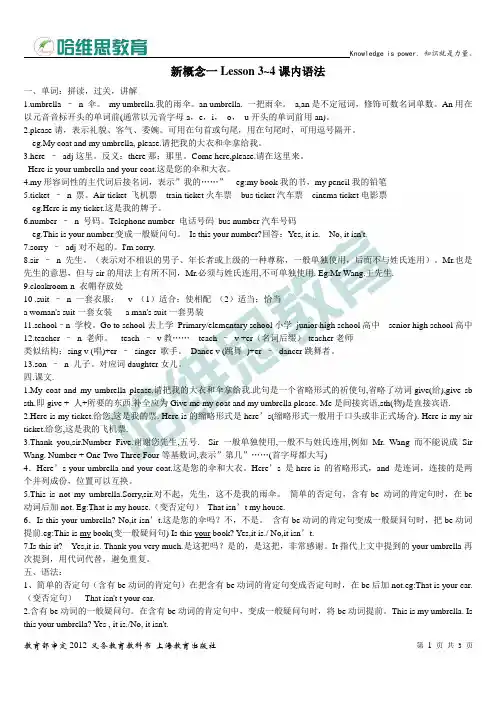
新概念一Lesson 3~4课内语法一、单词:拼读,过关,讲解1.umbrella –n 伞。
my umbrella.我的雨伞。
an umbrella. 一把雨伞。
a,an是不定冠词,修饰可数名词单数。
An用在以元音音标开头的单词前(通常以元音字母a,e,i,o,u开头的单词前用an)。
2.please请,表示礼貌、客气、委婉。
可用在句首或句尾,用在句尾时,可用逗号隔开。
eg.My coat and my umbrella, please.请把我的大衣和伞拿给我。
3.here –adj这里。
反义:there那;那里。
Come here,please.请在这里来。
Here is your umbrella and your coat.这是您的伞和大衣。
4.my形容词性的主代词后接名词,表示”我的……”eg:my book我的书,my pencil我的铅笔5.ticket –n 票。
Air ticket 飞机票train ticket火车票bus ticket汽车票cinema ticket电影票eg.Here is my ticket.这是我的牌子。
6.number –n 号码。
Telephone number 电话号码bus number汽车号码eg.This is your number.变成一般疑问句。
Is this your number?回答:Yes, it is. No, it isn't.7.sorry –adj对不起的。
I'm sorry.8.sir –n先生。
(表示对不相识的男子、年长者或上级的一种尊称,一般单独使用,后面不与姓氏连用)。
Mr.也是先生的意思,但与sir的用法上有所不同,Mr.必须与姓氏连用,不可单独使用. Eg:Mr Wang.王先生.9.cloakroom-n 衣帽存放处10 .suit –n 一套衣服;v (1)适合;使相配(2)适当;恰当a woman's suit一套女装 a man's suit一套男装11.school–n 学校。

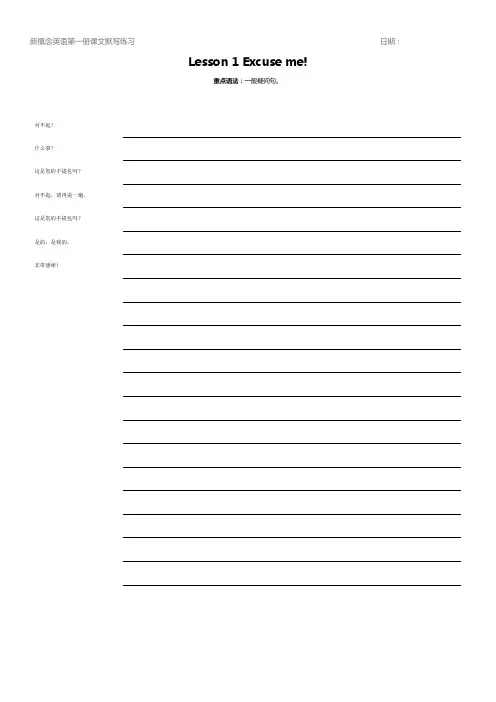
Lesson 1 Excuse me!重点语法:一般疑问句。
对不起!什么事?这是您的手提包吗?对不起,请再说一遍。
这是您的手提包吗?是的,是我的。
非常感谢!Lesson 3 Sorry, sir.重点语法:否定句。
请把我的大衣和伞拿给我。
这是我(寄存东西)的牌子。
谢谢,先生。
是5号。
这是您的伞和大衣这不是我的伞。
对不起,先生。
这把伞是您的吗?不,不是!这把是吗?是,是这把非常感谢。
Lesson 5 Nice to meet you.重点语法:1. 特殊疑问句。
以who, what, when, which, why, where, whose, how等引导的问句。
2. a / an。
布莱克先生:早上好。
学生:早上好,布莱克先生。
布莱克先生:这位是索菲娅.杜邦小姐。
索菲娅是个新学生。
她是法国人。
布莱克先生:索菲娅,这位是汉斯。
他是德国人。
汉斯:很高兴见到你。
布莱克先生:这位是直子。
她是日本人。
直子:很高兴见到你。
布莱克先生:这位是昌宇。
他是韩国人。
昌宇:很高兴见到你。
布莱克先生:这位是鲁明。
他是中国人。
鲁明:很高兴见到你。
布莱克先生:这位是晓惠。
她也是中国人。
晓惠:很高兴见到你。
重点语法:以What为引导的特殊疑问句。
罗伯特:我是个新学生,我的名字叫罗伯特。
索菲娅:很高兴见到你。
我的名字叫索菲娅。
罗伯特:你是法国人吗?索菲娅:是的,我是法国人。
索菲娅:你也是法国人吗?罗伯特:不,我不是。
索菲娅:你是哪国人?罗伯特:我是意大利人。
罗伯特:你是教师吗?索菲娅:不,我不是。
罗伯特:你是做什么工作的?索菲娅:我是电脑录入员。
索菲娅:你是做什么工作的?罗伯特:我是工程师。
重点语法:1. How…?用于交谈。
2. 形容词的用法。
史蒂文:你好,海伦海伦:你好,史蒂文史蒂文:你今天好吗?海伦:很好,谢谢你。
你好吗?史蒂文:很好,谢谢。
史蒂文:托尼好吗?海伦:他很好,谢谢。
埃玛好吗?史蒂文:她也很好,海伦。
史蒂文:再见,海伦。
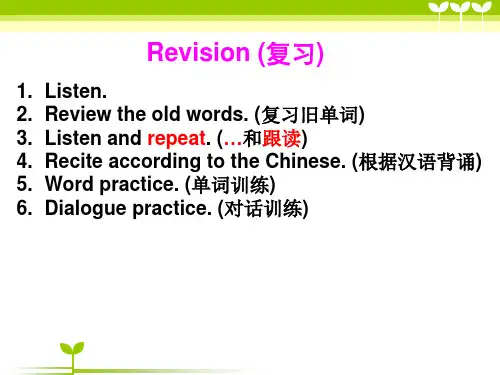
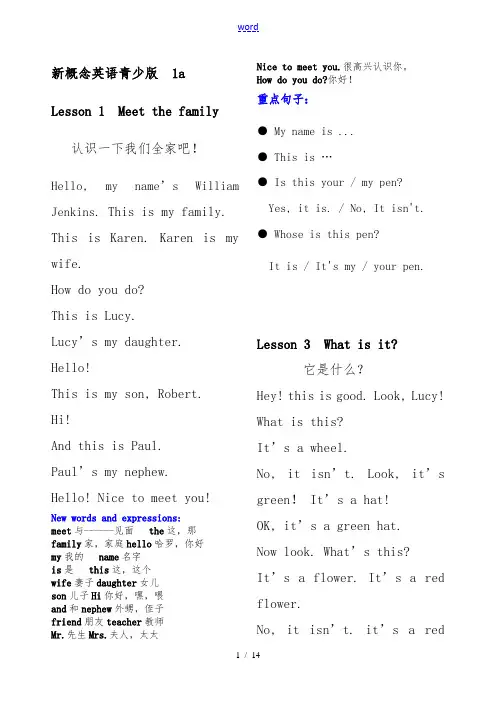
新概念英语青少版 1aLesson 1 Meet the family 认识一下我们全家吧!Hello, my name’s William Jenkins. This is my family. This is Karen. Karen is my wife.How do you do?This is Lucy.Lucy’s my daughter.Hello!This is my son, Robert.Hi!And this is Paul.Paul’s my nephe w.Hello! Nice to meet you!New words and expressions:meet与------见面the这,那family家,家庭hello哈罗,你好my我的name名字is是this这,这个wife妻子daughter女儿son儿子Hi你好,嘿,喂and和nephew外甥,侄子friend朋友teacher教师Mr.先生Mrs.夫人,太太Nice to meet you.很高兴认识你。
How do you do?你好!重点句子:● My name is ...● This is …● Is this your / my pen?Yes, it is. / No, It isn't.● Whose is this pen?It is / It's my / your pen.Lesson 3 What is it?它是什么?Hey! this is good. Look, Lucy! What is this?It’s a wheel.No, it isn’t. Look, it’s green!It’s a hat!OK, it’s a green hat.Now look. What’s this?It’s a f lower. It’s a red flower.No, it isn’t. it’s a redumbrella.OK, what’s that?It’s gr ey.Is it a bird?Yes! it’s a grey bird.No, it’s a key!Right!I t’s a silver key.New words and expressions:What什么Hey嗨Wheel轮子,车轮now现在flower花umbrella雨伞grey灰色的 table桌子key钥匙right正确的silver银色的chair椅子重点句子:● What is this / that ?● This is / That is / It is a hat/ an umbrella.● It is a red umbrella.● Whose is it? It's Robert's.●What colour is it? It's green. Lesson 5 Who’s that?那个人是谁?Who is that boy, Polly? Which boy, Annie?The boy on the silver bicycle. That’s Robert Jenkins. Who’s that man?Which man?Theman with the blackumbrella. That’s Mr. Jenkins.He’s Robert’s fathe r.Who’s that woman with the white umbrella?That’s Mrs. Jenkins.She’s Robert’s mother.And who’s that girl on the red bicycle?That’s Lucy Jenkins.She’s Robert’s sister.Look at that young man. Who is he?Which young man?The young man in that old car.Oh, that’s Paul.Paul is Lucy’s cousin.So, Paul is Robert’s cousin, too.That’s right.Robert is Lucy’s brother. And Paul is their cousin. He’s a student.New words and expressions:who 谁 which 哪一个with有,带着 old旧的look at看young年轻的cousin堂,表兄弟〔或姐妹〕too也so那么,这样看来their他们的new新的 student学生his他的her她的重点句子:● Who is that boy?● Which boy?● The boy on/in/with the ...● Is Robert's / Lucy's bicycle silver?● His / Her bicycle is red.Lesson 7 Robert isn’t well 罗伯特感觉不舒服Hello, Karen. How are you? I’m fine.But Robert isn’t very well. Oh, I’m sorry!What’s the matter with him? I’m not sure. He’s very hot. He isn’t well.Is he hungry?No, he isn’t hungry.Is he thirsty?Yes, he’s very thirsty.Poor Robert. I am sorry. What about the doctor?The doctor’s very busy. Yes, but Robert is ill. Perhaps not very ill.But you are right.Better safe than sorry.New words and expressions:Well健康的 how怎么样Fine舒适的but但是very非常sorry抱歉的,遗憾的What’s the matter with?---怎么了?him 他〔宾格〕sure确信的,肯定的hungry饿的doctor医生thirsty口渴的ill生病的poor 可怜的cold冷的What about?------呢?busy忙绿的are是perhaps或许,可能Better safe thansorry!有备无患!重点句子:● Robert is thirsty. He is not hungry.● Is he / she thirsty?Yes, he/she is. / No, he/she isn't.● How are you? How is he / she?● Who is thirsty? Robert is.●What is funny? This story is.Lesson 9 Meet the neighbors.认识一下邻居们!Hello! My name’s Paul.Hello Paul. My name’s Claire. I’m your new neighbor. Claire, that’s a nice name. What do you do, Claire?I’m a student. Wha t about you?I’m a student too.I’m at the sports academy. What about you?I’m an art student. I’m at the art college.e and meet Karen.She’s my aunt. She’s a writer.Karen, this is Claire. Claire’s our new neighbor. Hello, Claire. Nice to meet you.e and meet the family.This is William, my husband. This is Lucy and this Robert. How do you do, Claire.Hi, everybody.Thank you for the wele.New words and expressions:neighbour邻居nice美好的What do you do?你是做什么工作的?at 在art college艺术学院sports academy体育学院aunt姨妈,姑妈our我们的writer作家husband丈夫everybody每个人Thankyou!你!Wele欢迎for为了,因为重点句子:● Look at him / her / it.● Is he a teacher?Is he a student?Is he a teacher or a student?● Are you a teacher?Yes, I am. / No, I'm not.● What's his / her job?He's / She's a teacher.●What do you do?I'm a student / an accountant.Lesson 11 Gossip闲谈!Who’s that girl, Polly? Which girl, Annie? The girl over there. The tall girl with the Jenkins family. Oh, that’s Claire,our new neighbor.She’s an art student.Sh e’s a very pretty girl. Yes, she’s cleaver too. She’s a nice girl.Where’s she from?Is she English?No, she isn’t. She’s American. She’s from Washington.Is her family here, too? Yes. Her father’s an accountant. And her mother’s a famousphotographer.Look! That’s her mother over there.That womanin the expensive car?That’s right. She’s very pretty.Pretty? She’s beautiful. What about her husband?Is he handsome?Wait and see!New words and expressions:gossip闲谈overthere在那边tall 高的pretty漂亮的where在哪?from来自---nationality国籍here在这里English英国的American美国的London伦敦 Washington华盛顿famous著名的expensive昂贵的beautiful美丽的handsome英俊的wait等待see看到,看见重点句子:● where’s she from?She’s from Washington.● What nationality is she?She's English. She isn't French.● She's a pretty girl.Her mother's a famous photographer.● Look at that student.● That English student is tall.He's a tall English student.Lesson 13 Where’s my pen?我的铅笔在哪儿?Where’s my pen, Lucy?Which pen, Mum?The blue one.This one?Yes,that one.It’s my favorite pen, Lucy! Sorry, Mum.And where’s my new rule r? The long one?The long silver one.It’s in my school bag, Mum. Oh, Lucy!Give me my ruler, please. Here you are. I’m sorry, mum. It’s a very nice ruler. Yes, it is. Mum!Yes?Is this your pencil-case, too?No, it isn’t.It’s your father’s old pencil-case.That’s his favorite thing. Sorry, Mum!It’s myfavorite thing, too. Oh, well. Put it on his desk. No harm done.Thanks, Mum.New words and expressions:favorite最喜欢的long长的schoolbag书包give给please请Here you are .给你。
(完整word版)新概念第⼀册课⽂默写修改版.doc 课⽂ 1对不起!1. _______________________________对不起2._______________________________什么事?3._______________________________这是您的⼿提包吗?4. _______________________________对不起,请再说⼀遍。
5._______________________________这是您的⼿提包吗?6._______________________________是的,是我的。
7._______________________________⾮常感谢!课⽂ 3 对不起,先⽣。
8._______________________________请把我的⼤⾐和伞拿给我。
_______________________________这是我(寄存东西)的牌⼦。
_______________________________谢谢,先⽣。
11._______________________________是 5 号。
12._______________________________这是您的伞和⼤⾐13._______________________________这不是我的伞。
14._______________________________对不起,先⽣。
_______________________________这把伞是您的吗?是,是这把19._______________________________⾮常感谢。
课⽂ 5 很⾼兴见到你。
20._______________________________早上好。
21._______________________________早上好,布莱克先⽣。
22._______________________________这位是索菲娅. 杜邦⼩姐。
裕兴版新概念英语笔记第一册第3课-CAL-FENGHAI.-(YICAI)-Company One1Lesson 3 Sorry, sir语音—中元音中元音:[Λ][ə:] [ə]★中元音:[Λ]--发音时舌的活动部位是在口腔的中部。
[Λ]u o ou口腔几乎全开,嘴唇成自然状态,短音。
[Λ]-uup 向上 shut 关上 cup 茶杯 bus 公共汽车 much 许多 lunch 午餐[Λ]-oson 儿子 honey 蜜,亲爱的人 money 钱 other 其它的[Λ]-ouenough 足够的 cousin 侄子 young 年轻的Read these sentences:1. You shut up. 你闭嘴。
2. My son has much money. 我儿子有许多钱。
3. His son always comes here for money. 他的儿子总是来这儿要钱。
4. Her young cousin has enough money for the lunch. 她的小侄子有足够的钱付这顿午餐。
★中元音:[ə:]—ir ur or er ear口腔半开,嘴唇成自然状态,长音。
[ə:]-irbird 鸟 first 第一 girl 女孩 dirty 脏的 shirt 衬衫[ə:]-urturn 翻转 church 教堂 nurse 护士 burn 燃烧[ə:]-orwork 工作 worm 虫子 word 单词 world 世界 worse 更坏的[ə:]-erverb 动词 mercy 同情[ə:]-earearly 早的,早地 earth 地球 search 搜寻Read these sentences:1. This nurse wears a dirty skirt. 这位护士穿了一件脏裙子。
2. It’s the early bird that catches the worm.早起的鸟儿有虫吃。
新概念英语第一册第3课笔记小红书全文共3篇示例,供读者参考篇1Title: Notes on New Concept English Book One Lesson ThreeLesson Three: A Puma at LargeIntroduction:In this lesson, we learn about a terrifying experience of meeting a puma in Latin America. The author narrates the incident to give us an insight into the dangers of encountering wild animals in their natural habitat. Let's delve into the key points discussed in this lesson.Key Points:1. Setting: The story is set in a remote region of Latin America where the author, a sportsman, goes on a hunting expedition. The vast wilderness and dense foliage add to the suspense of the story.2. Encounter with the Puma: The author comes face to face with a puma, a large and powerful wild cat. The description ofthe puma's appearance and behavior is chilling, instilling fear in the readers.3. Survival Instincts: Despite feeling terror-stricken, the author manages to keep his wits about him and devise a plan to escape from the puma. His quick thinking and resourcefulness are commendable in the face of danger.4. Lesson Learned: The author reflects on the experience and realizes the importance of respecting nature and its inhabitants. He acknowledges the fragility of human life in the presence of powerful predators like the puma.5. Moral of the Story: The lesson imparts a valuable message about the need for caution and awareness when exploring unknown territories. It serves as a reminder of the risks involved in venturing into the wilderness unprepared.Conclusion:Lesson Three of New Concept English Book One offers a gripping narrative of survival and resilience in the face of danger. The story serves as a cautionary tale for readers, highlighting the importance of respecting nature and being mindful of the perils that lurk in the wild. As we navigate through life's challenges, letus remember the lessons learned from this harrowing encounter with a puma at large.篇2Title: Notes on Lesson 3 of New Concept English Book OneIn lesson 3 of the New Concept English Book One, we learn about the usage of the present perfect tense. This tense is formed by combining the auxiliary verb "have" with the past participle of the main verb. In lesson 3, we see how the present perfect tense is used to talk about actions or events that happened at an unspecified time in the past or that have relevance to the present.One of the key points in this lesson is the difference between the simple past and the present perfect tense. While the simple past is used to talk about specific times in the past, the present perfect tense is used to talk about experiences or actions that have happened at some point in the past but have a connection to the present. For example, in the sentence "I have seen that film before," the speaker is indicating that they have had the experience of watching the film at some point before now.Another important aspect of the present perfect tense is the use of adverbs of time, such as "already," "yet," and "just." Theseadverbs help to clarify the time frame of the action or event being described. For example, "Have you finished your homework yet?" implies that the action of finishing the homework has not yet happened.In lesson 3, we also learn about the use of the present perfect tense with the adverbs "ever" and "never." These adverbs are used to describe experiences throughout one's life. For example, "Have you ever been to Paris?" implies that the speaker is asking about the listener's entire life experience, not just a specific time frame.Overall, lesson 3 of the New Concept English Book One provides a clear explanation of the present perfect tense and its uses. By understanding this tense, we can communicate more effectively in English and express our experiences and actions more accurately.篇3Title: Notes on Lesson 3 from New Concept English - Little Red BookLesson 3 in the New Concept English series is a continuation of the basics of English grammar and vocabulary. In this lesson, we learn about prepositions of place, such as 'in', 'on', and'under'. Additionally, we learn how to construct simple sentences using these prepositions to describe the location of objects.1. Prepositions of Place:- In: Used to describe something inside a space or container. For example, "The cat is in the box."- On: Used to describe something on a surface. For example, "The book is on the table."- Under: Used to describe something below or covered by something else. For example, "The ball is under the chair."2. Sentence Structure:- Subject + Verb + Preposition + Object: This is the basic structure of sentences using prepositions of place. For example, "The pen is on the desk."3. Practice Exercises:- Complete sentences using the correct preposition. For example, "The keys are ______ the bed." (Answer: under)- Identify the correct location of objects in pictures. For example, "Where is the dog? On the roof, under the table, or in the car?"In conclusion, Lesson 3 in the New Concept English series is a fundamental building block for understanding prepositions of place in English. By practicing sentence construction and identifying the correct location of objects, students can improve their grammar skills and expand their vocabulary.。
Lesson1: Excuse me!Excuse me!Yes?Is this your handbag?Pardon?Is this your handbag?Yes, it is.Thank you very much.Lesson 3:Sorry sir。
My coat and my umbrella please. Here is my ticket。
Thank you sir。
Number five。
Here is your umbrella and your coat. This is not my umbrella。
Sorry sir。
Is this your umbrella?No, it isn't。
Is this it?Yes, it is。
Thank you very much。
Lesson 5: Nice to meet you。
Good morning.Good morning,Mr. Blake.This is Miss Sophie Dupont.Sophie is a new student.She is a French。
Sophie, this is Hans.He is German。
Nice to meet you。
And this is Naoko。
She’s Japanese.Nice to meet you。
And this is Chang—woo。
He’s Korean。
(朝鲜人)Nice to meet you.And this is Luming.He’s Chinese。
Nice to meet you.And this is Xiaohui.She’s Chinese, too。
Nice to meet you。
Lesson 7: Are you a teacher? I'm a new student。
My name’s Robert.Nice to meet you。